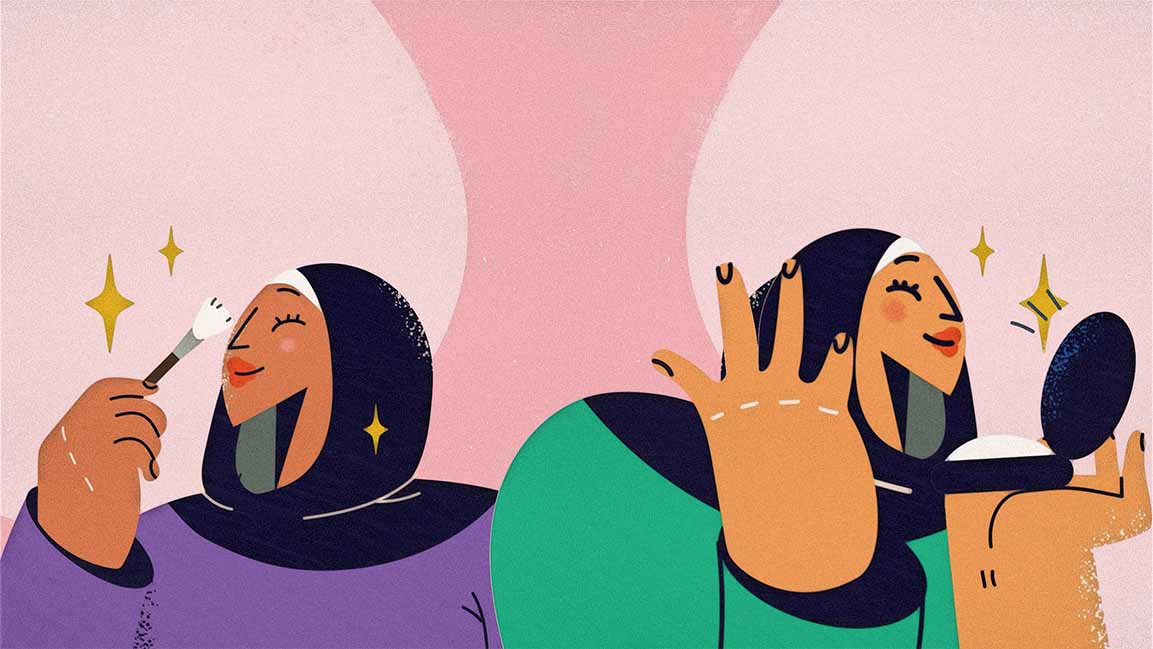- | 9:00 am
Gen Z in the Middle East don’t like beauty standards — so they’re changing it
Brands are adjusting their marketing strategies to align themselves with this discerning generation.

The beauty industry has historically been a vector for reinforcing cultural norms. However, in the Middle East, Gen Z, known for its conscious habits, is rewriting the narrative of beauty standards, deviating away from Westernized ideals, celebrating their diverse heritage, and pushing for inclusivity in the beauty space.
“As an Arab, I take pride in showcasing my culture through items like abayas or keffiyehs. Remaining connected to your country through your attire is important to who you are,” says Sarah Ghanem, an 18-year-old marketing student at Heriot-Watt University in Dubai.
Clearly, Gen Z is using the space to advance identity and belonging.
Prachi Bishnoi, Founder and Chief Creative Officer of digital marketing agency Glomm Digital, says that Gen Z in the region is highly aspirational.
“Their global exposure fosters brand awareness; they embrace diverse cultures, promoting fusion in lifestyle choices. This generation’s influence extends to local markets, introducing international brands and trends, reshaping the region’s cultural and economic landscape.”
This shift is forcing brands to rethink their marketing strategies.
“They must decide between adopting a globally inclusive approach, which may appear larger than life, or tailoring their messaging to resonate with the diverse local cultures, addressing their lifestyles and preferences,” says Bishnoi.
Chalhoub Group’s beauty report, Decoding the Beauty Consumer in the GCC, highlights a notable transition in beauty perceptions within the GCC market, embracing Arabic beauty and features specific to the Middle East.
Consumers now prioritize subtler cosmetic enhancements that uphold their unique beauty, emphasizing “internal beauty,” which encompasses health, wellness, and self-confidence.
To cater to Gen Z, brands must balance global appeal with local relevance in their marketing.
“We aim to craft content that seamlessly blends the richness of local culture and language with global trends, ensuring it resonates with the diverse audience while maintaining an aspirational quality. This delicate balance is key to our success in this dynamic market,” says Bishnoi.
IMPACT OF SOCIAL MEDIA
Gen Z prioritizes authenticity and a genuine connection with the brands they support. Their purchase decisions are heavily influenced by peer recommendations and user-generated content, which they find more trustworthy and relatable than traditional advertising.
“A notable trend is emerging among the new generation of influencers who skillfully infuse their content with a deep appreciation of their culture. This fusion sets them apart and makes them highly sought-after figures. Gen Z, in particular, is embracing a more open and inclusive attitude towards global cultures,” says Bishnoi.
A study by Snap Inc. and Havas Media Network revealed the significant role social media plays in UAE consumers’ shopping journey. Over half (54%) discover new products and brands through social platforms, while 50% rely on them for reviews and recommendations.
Ghanem says social media significantly impacts her decisions. She relies more on content from creators unaffiliated with brands to gauge the authenticity of a product. “If I were to buy something, I would search it on TikTok first and see people’s opinions. Although some may not be as truthful as I would like, many influencers are honest.”
Similarly, 24-year-old Mariam Tarek reflects on the evolution of social media and diversity.
“No one looked like me, no one’s skin looked like mine, no one’s body looked like mine, and everyone’s hair was straight,” she recalls. “Back then, conforming my Arab/African/Middle Eastern features to the prevailing trends on social media was a struggle.”
However, there is a clear change in today’s beauty and fashion standards. “I can find a little of myself in everyone else, comforted by people who look like us; that wasn’t the case a few years ago,” adds Tarek. “It’s not just a matter of looks or style; it’s a matter of mindset, too. We all fit together, outside of what’s ‘normal’.”
BUYING LOCAL
The brands that have embraced this shift the most tend to be local, leveraging their ability to concentrate on a more specific target audience and demographic, refining their unique selling propositions.
Tarek explains that her initial attraction to local brands stemmed from the prevailing economic situation. However, her perspective has evolved, transforming into a fundamental principle. “I lean more towards brands that showcase my Arab identity.”
“Part of it is rooted in my pride for the numerous talented young Egyptian artists who deserve support, reconsidering international brands and what they stand for,” says Tarek.
“Our generation has had the chance of growing up with a mentality that allows for out-of-the-box thinking. We don’t just buy things from a certain brand because everyone does; we research, look up brand values, and do the work before financially committing to the one brand.”
Ghanem echoes Tarek’s points: “I like to look at the economic side of it; the more I support local businesses, the more they will be able to grow and branch off. Additionally, local businesses are more likely to stand against animal cruelty and politics.”
“I am not only buying from them, I am also funding their actions as a company. If their morals do not align with mine, I would rather buy something different,” Ghanem adds.
BRAND STRATEGIES
As a result of this shifting behavior, brands are swiftly adjusting their marketing strategies to align themselves with this discerning generation.
“This global mix of culture is challenging; hence, in this region, either we go with an evolved communication, or we cater to a local culture and try to address their lifestyles and choices,” says Bishnoi.
Unsurprisingly, brands are turning to TikTok and Instagram for marketing, or employing guerrilla marketing, which works on the element of surprise and unconventional interactions to communicate with target audiences, and convince people to cave and make their purchases.
“Not all brands do this; I have seen many that just make memes and such, which, honestly, does make me buy from them,” says Ghanem.
Recently, some brands have taken on an entirely Palestinian identity to support and reflect the cause. However, Gen Z’s hyper-awareness of social causes makes them more than aware of brands that take advantage.
“This shift in identity and the many campaigns on social media has resulted in many Gen Z and Gen Alpha youth to educate themselves on what is happening in the world. With this education comes a responsibility to boycott certain brands and open ourselves to new brands, locally grown ones,” adds Tarek.







































